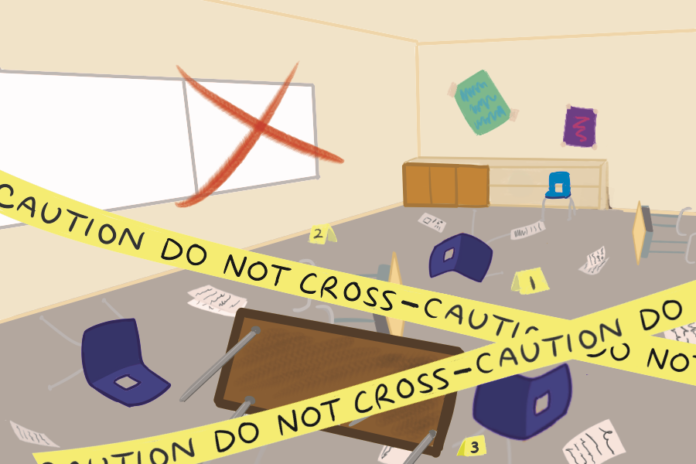The constant fear of school shootings haunts an entire generation
By CLAIRE SCHAD — cfschad@ucdavis.edu
Content warning: this article contains discussions of gun violence that some readers might find disturbing.
I was in fifth grade when I heard about 26 people being killed at an elementary school in Newtown, Connecticut. I remember watching my parents as then President Barack Obama gave a teary address on national television. I had been doing lockdown drills at school for many years, but I hadn’t really understood what we were hiding from — Sandy Hook made it clear.
I was a sophomore when a gunman shot and killed 17 people at a high school in Parkland, Florida. I remember getting in the car after softball practice and listening to the news on the radio as tears filled my mom’s eyes. This time it was a high school; those killed were my age. This could happen to me, I thought.
The fear among students at my high school was painfully apparent in the weeks and months following the shooting in Parkland. One morning, the fire alarm was pulled, and instead of evacuating to the football field, we all rushed to the nearest classroom and our teachers frantically locked their doors. We were scared the fire alarm was being used to lure us outside; we had heard that the fire alarm went off as the shooting unfolded in Parkland. Although no one was harmed, it was traumatic, and many students went home early because they felt unsafe.
A few months later, we were ushered into an assembly where we were taught about the “run, hide, fight” philosophy. We were shown videos depicting a staged active shooter event and told what to do. To the backdrop of daunting music you would find in a horror movie, we were told where we should run and how we should fight: act aggressively, throw textbooks and improvise weapons, the videos instructed us.
The lessons we were taught in elementary school about hiding and staying quiet were no longer good enough. Now, we had to be prepared to fight too.
Mid-February, three students were killed and five were wounded by an active shooter at Michigan State University (MSU). Again, we were reminded that our campuses are no longer safe.
As the event unfolded at MSU, students were sent a campus alert instructing them to “run, hide, fight.” Many people were shocked that this was the message being sent to students going through an active shooter situation. However, the instructions given to MSU students and the concepts I learned during an assembly my sophomore year are part of a larger framework created by the Department of Homeland Security and promoted by other federal groups.
The problem is being acknowledged — students are being taught to fight back. And yet, the shootings continue. When will the root of the problem be addressed? Damage control is understandable, but not without real action being taken to eliminate the constant threat.
Of the students who went through the trauma at MSU, there were multiple for whom it wasn’t their first school shooting. Some had been students at Oxford High School, just 80 miles east, where four students were killed 14 months earlier. Another student was in sixth grade at Sandy Hook when the deadly shooting occurred in 2012.
We have gotten to a point where children are going through multiple school shootings before they have had the chance to graduate college. When will this stop?
We are the generation constantly looking for places to hide and exit routes out of our classrooms. As we sit through our lectures some of us think about what we would do if a person with a gun came in. We have sat in classrooms shoulder-to-shoulder with our peers, unsure if it’s just a drill or the “real deal.” We send our loved ones texts that we are on lockdown and tell them we love them. This is what life is like for the school-shooting generation.
We have watched these horrific events increase in frequency over the course of our lifetimes. Sandy Hook, Michigan State, Parkland, Uvalde, Oxford, University of Virginia. I could keep going, but the list would take multiple pages. How many more have to happen for real and effective change to be made? When will it stop?
Written by: Claire Schad — cfschad@ucdavis.edu
Disclaimer: The views and opinions expressed by individual columnists belong to the columnists alone and do not necessarily indicate the views and opinions held by The California Aggie.




